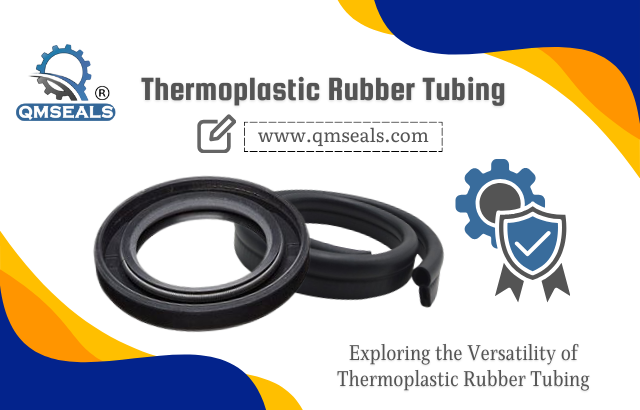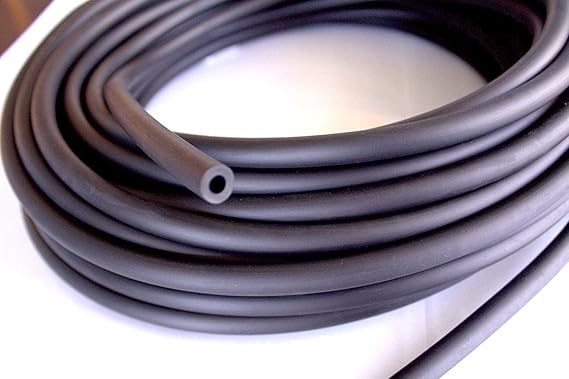Posted At: Feb 18, 2025 - 469 Views

Exploring the Versatility of Thermoplastic Rubber Tubing
Introduction
Thermoplastic rubber (TPR) has become a game changer in many different industries due to its flexibility, durability, and resistance to extreme conditions. Probably one of its most valuable applications is in the form of thermoplastic rubber tubing, used in a vast number of applications across different industries because of its adaptability and performance. Thermoplastic rubber is a combination of the elastic behavior of rubber along with the processibility of the thermoplastics. It finds flexibility, abrasion resistance, and great chemical stability along with durable long life cycles of usage, making its use vast within the realms of industrial usage. Specifically in the areas where tubing requires considerable strength with adequate elasticity or even resilience and robustness simultaneously in a few industrial applications. Thermoplastic rubber tubing-What is this product? This blog will cover the different uses of thermoplastic rubber tubing and its key specifications.
What is Thermoplastic Rubber?
Thermoplastic rubber, also known as thermoplastic elastomer (TPE), is a versatile polymer material that combines the properties of plastic and rubber. Unlike traditional rubber, it can be melted and reshaped multiple times without losing its inherent characteristics, making it more adaptable and environmentally friendly. TPR is widely used in manufacturing flexible components such as seals, gaskets, footwear, and tubing due to its excellent elasticity, chemical resistance, and durability. Its ability to be re-moulded repeatedly without degradation makes it an ideal choice for applications requiring flexibility, ease of processing, and resilience.
Properties and Benefits of Thermoplastic Rubber Tubing

Flexibility and Durability: TPR tubing is very flexible. It is used in dynamic applications where movement and bending are necessary. It has great fatigue resistance, thus enabling it to last longer, even under constant usage.
Chemical and Temperature Resistance: Resistant to various oils and solvents as well as other chemicals, therefore suitable for industrial purposes. It has a resistance to extreme temperatures, withstanding very hot and cold situations where it is still able to perform well.
Lightweight and Easy to Process: Lighter than traditional rubber tubing, making it easier to handle and install. It can be produced through extrusion, injection molding, and other efficient processes.
Eco-Friendly and Recyclable: Unlike traditional rubber, TPR tubing is recyclable, which minimizes environmental impact. Non-toxic and free from harmful chemicals, making it safe for medical and food-grade applications.
Common Applications of Thermoplastic Rubber Tubing
Medical and Healthcare Industry: Used in medical devices, respiratory equipment, and intravenous (IV) applications. It is compliant with strict FDA and USP Class VI standards for safety.
Automotive and Transportation: It is used in fuel lines, air hoses, and coolant transfer systems. Resistant to oil and fuel exposure, it is perfect for use in the automotive industry.
Food and Beverage Industry: It is used in beverage dispensing, dairy processing, and food production. Non-toxic and compliant with food safety regulations.
Industrial and Manufacturing: It is used in pneumatic systems, hydraulic hoses, and chemical transfer. It is resistant to harsh chemicals and extreme working conditions.
Home Appliances and Consumer Products: Available in plumbing systems, flexible tubes, and domestic appliances. Utilized for sports and protection apparatus as TPR has great durability.
Chemical and Pharmaceutical Industry:
TPR tubing is highly resistant to a wide range of chemicals, acids, and solvents, making it ideal for chemical transfer applications. It is used in laboratories, pharmaceutical manufacturing, and industrial fluid handling systems.
The tubing is resistant to harsh chemical exposure and does not contaminate. This maintains the integrity of the process.
Agriculture and Irrigation:
Thermoplastic rubber tubing is used in agricultural applications like irrigation systems and fertilizer distribution. It is resistant to UV and weather conditions. This makes it suitable for outdoor applications. The flexibility of the tubing makes it easy to install in irrigation networks.
Construction and HVAC Systems:
In construction, the TPR tubing is applied to distribute water and air. It is an integral part of HVAC (Heating, Ventilation, and Air Conditioning) systems for efficient airflow management. The thermal insulation properties of the tubing help in maintaining energy efficiency in heating and cooling systems.
Key Specifications of Thermoplastic Rubber Tubing
When choosing thermoplastic rubber tubing for a particular application, there are several key specifications to consider. These include:
1. Material Composition
TPR tubing is usually made from a combination of rubber and plastic polymers, ensuring flexibility and durability. Some may have added UV resistance, antimicrobial characteristics, or even higher chemical resistance.
2. Temperature Range
The operating temperature range of TPR tubing lies between -40°C to 135°C (-40°F to 275°F). This places it in extreme cold and high-temperature uses.
3. Chemical Resistance
Thermoplastic rubber tubing is resistant to a wide variety of chemicals: oils, greases, acids, and solvents. It is also resistant to UV radiation, ozone, and other environmental factors as well.
4. Flexibility and Elasticity
The excellent flexibility of the TPR tube makes it convenient for easy installation and handling of the tubing system. It continues to be highly elastic even with extended usage in service, guaranteeing a safe fit and optimal performance.
5. Hardness and Durometer
TPR tubing is made available in several hardness levels on the Shore A or Shore D durometer. Application-dependent hardness selection: softer tubing is used for peristaltic pumps, while harder tubing is the preferred option for high-pressure applications
6. Inner Diameter (ID) and Outer Diameter (OD)
TPR tubing comes in several sizes with precise diameters at both the inner and outer sides for different industrial applications. Custom sizes can be manufactured on particular requirements for specific applications
7. Burst Pressure and Tensile Strength
The tubing must be resistant to high pressure and not break or burst, so it is excellent for pneumatic and hydraulic applications. Tensile strength will ensure durability against mechanical stress and bending forces.
8. FDA and NSF Compliance
For food and medical applications, TPR tubing must be compliant with FDA (Food and Drug Administration) and NSF (National Sanitation Foundation) standards. Compliance ensures that the tubing is safe for contact with food, beverages, and medical fluids.
Emerging Trends for Thermoplastic Rubber Tubing
Innovative Eco-friendly Materials: TPR tubing in biodegradable and environmentally friendly versions is of significant interest among manufacturers
Tubing with Implants of Sensors: There are active studies under which sensors will be incorporated within the tubing that would give instantaneous feed in both medical and industrial fields.
Nano-Based Superior Performance: Nanomaterials are added for increased strength, durability, and chemical resistance.
Conclusion
Thermoplastic rubber tubing is a game-changer across various industries because of its flexibility, durability, and resistance to chemicals and extreme temperatures. As material science advances, TPR tubing will be even more efficient and sustainable. Its versatility in medical, automotive, industrial, and consumer applications makes it an essential component in modern manufacturing. Thermoplastic rubber tubing is a widely used item in industries for its flexibility, chemical resistance, and high durability. Whether applied for automotive, medical, food processing, or industrial uses, it is taken as an essential part of maintaining the transportability of fluids and gases with high efficiency. If the primary specification of TPR tubing is understood, then the correct TPR tubing can be selected for specific needs. Whether you need tubing for high-pressure applications, chemical transfer, or food-grade use, thermoplastic rubber tubing is a great option that's reliable and cost-effective.
For high-quality thermoplastic rubber tubing, choose a supplier that adheres to industry standards and provides customized solutions for your application requirements.
Frequently Asked Questions
1. What is thermoplastic rubber?
Thermoplastic rubber (TPR) is a material that combines the flexibility of rubber with plastic's processability. It makes it ideal for use in any number of applications, including tubing.
2. How is TPR tubing compared to silicone tubing?
TPR tubing is easier to recycle and cheaper than silicone. Silicone gives superior heat resistance.
3. Is there TPR tubing to be used in the preparation of food and beverages?
Yes, TPR is non-toxic and complies with FDA standards for food and beverage processing.
4. Is TPR tubing resistant to high temperatures?
Yes, TPR tubing is in a wide temperature range, from -50°C up to 150°C, making it ideal for demanding applications.
5. Is thermoplastic rubber tubing resistant to chemicals?
Yes, TPR tubing is very resistant to oils, solvents, and a variety of chemicals, making it ideal for industrial applications.
6. Is TPR tubing recyclable?
Yes, thermoplastic rubber is recyclable, which makes it an eco-friendly option.
7. Which are the most common industries that utilize thermoplastic rubber tubing?
TPR tubing is widely used in medical, automotive, food and beverage, industrial manufacturing, and consumer goods industries.
8. Is TPR tubing flexible?
It is very flexible, so it can be used in applications that bend and move constantly.
9. How does thermoplastic rubber tubing compare to PVC tubing?
TPR tubing is more flexible, chemical-resistant, and eco-friendly than PVC tubing but could be a bit pricier.
10. Where can I buy high-quality thermoplastic rubber tubing?
High-quality TPR tubing is available from specialized manufacturers, industrial suppliers, and online marketplaces.


